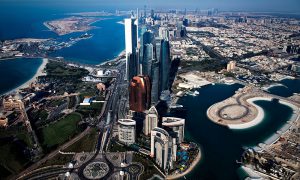The circular model
Malek Sukkar on moving away from ‘take-make-waste’ to a smarter paradigm

Malek Sukkar on moving away from ‘take-make-waste’ to a smarter paradigm
City planning over the past few decades has evolved to focus on sustainable development, especially in light of rapid urbanisation in metropolises across the world. In tandem with this population growth, a global spike in technological connectivity has propelled the once vague notion of smart cities into the forefront of urban mapping.
From routing a daily commute to engaging emergency services in times of crisis, the smart city model is a brave new structure that works on the back of instant access and transparency.
Enhancing the lives of residents through improved performance, efficiency and functionality, smart cities take on an integrated approach in terms of their infrastructure, following a circular economic model, where resources are streamlined through a cyclical manufacturing and consumption process.
Smart technologies enable the waste industry to grow beyond a collect-and-transport role, and become an integrated waste solutions provider, by giving it access to vast amounts of usable data for quality control. An integrated IT system enables a high level of mobility, connecting trucks, drivers and supervisors to amass quantities of analysable data. Managing the waste collection trucks through vehicle tracking, waste management companies are now able to pinpoint specific details of location, speed and behaviour of drivers.
Dynamic weighing on lifters relays data on the volume and weight of the collected waste. Radio-Frequency Identification (RFID) technology on bins, trucks and sites notes public behavioural trends in residential, commercial and municipal areas in real time, which is then centrally available for waste management companies and municipal bodies to keep track of volume and type of waste, and how it is being managed, for both quality control and as a platform to build awareness.
An ideal world
Waste as a concept arises only in our current ‘take-make-waste’ linear economic model. The laissez-faire archetype followed by the majority of the world plays the forces of supply and demand off each other, leading to manufacturing on a scale that has never been seen before. What happens to products at the end of their useful life? How is the lifespan of products determined now, considering the rapid rate of obsolescence? The circular economic model addresses these questions by moving away from a one-way trajectory, promoting a regenerative system where waste becomes input.
In our current scenario, about 4bn metric tonnes of waste is produced around the world, of which only 1bn is turned into energy, materials or compost. Establishing a circular economy would minimise the need for resources and reduce our impact on the environment. Further, this model would introduce cost-effective methods of production and consumption through a broad variety of innovative solutions, to get the most out of waste.
From collecting waste seamlessly and segregating it at the point of collection, to recycling it based on its contents to reintroduce valuable resources like precious metals, paper and plastic, waste management in the smart city model would shift consumption patterns and public behaviour by default, stimulated by the economic incentives surrounding sourcing valuable materials.
At the precarious edge of this fantastic future, present-day researchers face massive challenges, particularly in maintaining the quality and value of recycled materials, which starts from clear and conscientious waste segregation. Once materials are tainted by organic waste, their reusability drops significantly. This is where building awareness in this new paradigm is critical.
The importance of waste segregation in the context of a smart city will instinctively be recognised by the private and public sectors when it directly relates to the worth of otherwise highly valued raw materials. The depreciation of this value is enough to drive legislation in a top-down socioeconomic model, in order to encourage the separation of waste and recycling processes to extract these resources.
In a bottom-up socioeconomic model, the private sector would be the leader of this change, implementing a holistic model for product collection and reintroduction in the manufacturing cycle.
If this model sounds too idealistic to be feasible, it may be because the linear economic model is so globally pervasive. In Europe, smart cities like Amsterdam and Barcelona thrive on the circular economic model.
Smart cities offer the opportunity to integrate every aspect of development, eradicating the concept of waste as we’ve come to know it in recent history – moulding living, breathing cities that are adaptable, robust and a delight to live in.
(Malek Maysarah Sukkar is the CEO of averda, one of the fastest growing waste management services providers in the developing world)


























